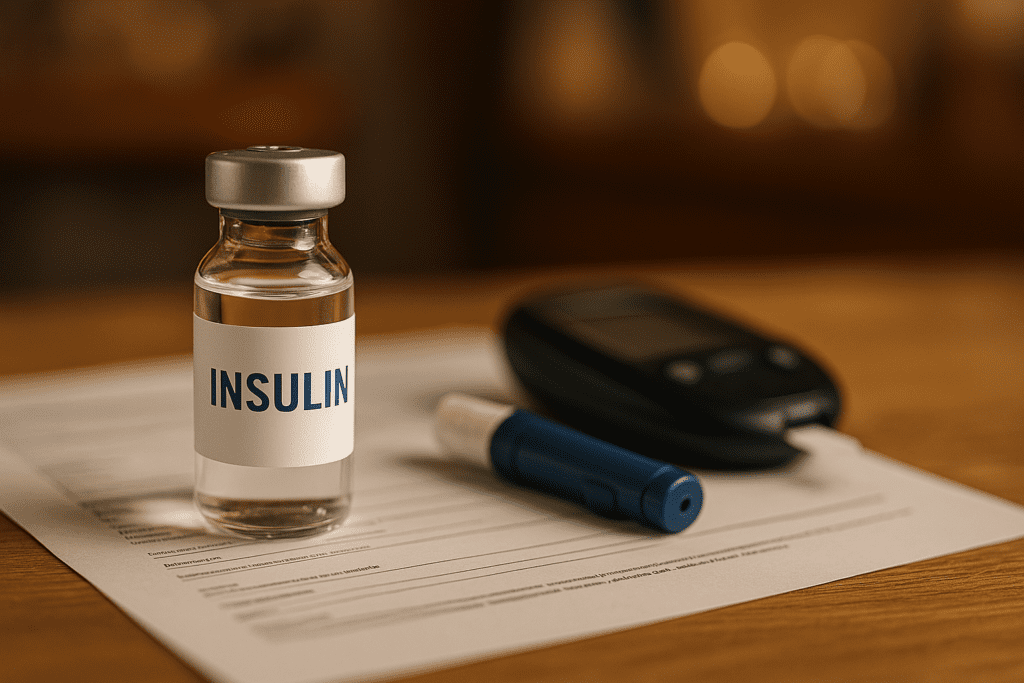A Deeper Look Into the Epidemic of Type 2 Diabetes
Type 2 diabetes continues to rise at an alarming rate worldwide, affecting over 400 million individuals as of the latest global health estimates. This chronic metabolic condition, once considered a disease of affluence or aging, now affects people across all age groups, socioeconomic statuses, and cultures. At the heart of the disease lies a complex and often misunderstood process: insulin resistance. It is the cornerstone of type 2 diabetes, intricately tied to its onset, progression, and potential for reversal. Despite decades of research, our understanding of insulin resistance has been hampered by its multifactorial origins and dynamic behavior. Yet, recent advances are changing that narrative.
You may also like: Breakthroughs in Current Diabetes Research: What the Latest Studies Reveal About Treatment and Prevention
This article explores the latest breakthroughs in insulin resistance: what new research reveals about type 2 diabetes and emerging treatments that offer promise, precision, and potentially a path to prevention. Drawing from cutting-edge studies, translational medicine, and bioengineered therapeutics, we examine how these scientific strides are redefining both clinical care and long-term outcomes for patients navigating life with type 2 diabetes.
Understanding Insulin Resistance: Beyond the Basics
Insulin resistance occurs when cells in the muscles, fat, and liver become less responsive to insulin, the hormone responsible for facilitating glucose uptake from the bloodstream. In this compromised state, the pancreas compensates by producing more insulin to maintain normal blood glucose levels. Over time, this compensatory mechanism begins to fail, leading to sustained hyperglycemia—a hallmark of type 2 diabetes.
While this general mechanism is well known, the biological underpinnings of insulin resistance are more nuanced. Recent research suggests that chronic inflammation, mitochondrial dysfunction, lipid accumulation in tissues, and even the gut microbiome play critical roles in disrupting insulin signaling pathways. These discoveries are helping scientists reframe type 2 diabetes not merely as a disease of carbohydrate metabolism but as a multi-system inflammatory and endocrine disorder.
A growing body of work also implicates endoplasmic reticulum stress and oxidative stress in the development of insulin resistance. These cellular stress responses interfere with insulin receptor signaling, further compounding the resistance. Importantly, this mechanistic clarity is guiding the development of more targeted therapeutic strategies, which aim not just to lower blood sugar but to restore metabolic health at the cellular level.

The Genetic and Epigenetic Landscape of Type 2 Diabetes
One of the most exciting recent developments involves uncovering the genetic and epigenetic contributions to insulin resistance. Genome-wide association studies (GWAS) have identified multiple loci associated with type 2 diabetes susceptibility, many of which affect genes that regulate insulin secretion, insulin receptor function, or beta-cell development.
However, it is the field of epigenetics—modifications to DNA that do not change the genetic code but influence gene expression—that has added a fascinating dimension to our understanding. Environmental exposures such as diet, stress, and toxins can induce epigenetic changes that heighten the risk for insulin resistance. For instance, hypermethylation of insulin signaling genes can reduce their expression, impairing glucose uptake.
Moreover, these epigenetic modifications may be reversible, offering a tantalizing therapeutic opportunity. Researchers are now exploring interventions that can modulate epigenetic markers, potentially resetting the metabolic trajectory of at-risk individuals. These breakthroughs in insulin resistance—what new research reveals about type 2 diabetes and emerging treatments—underscore the dynamic nature of this condition and the need for flexible, individualized care strategies.
Adipose Tissue as an Endocrine Organ: Rethinking Fat’s Role
Historically, adipose tissue was viewed as a passive storage depot for excess energy. Today, it is recognized as a potent endocrine organ that secretes a wide range of bioactive molecules—adipokines—that influence insulin sensitivity, inflammation, and metabolic regulation. Dysregulated adipokine profiles, especially elevated levels of resistin and decreased adiponectin, have been closely linked with type 2 insulin resistance.
Recent studies have shown that visceral fat, the kind that accumulates around internal organs, plays a more harmful role than subcutaneous fat. Visceral adiposity promotes the release of inflammatory cytokines and free fatty acids that interfere with insulin signaling. Interestingly, reducing visceral fat through specific interventions like intermittent fasting, GLP-1 receptor agonists, or bariatric surgery has been shown to significantly improve insulin sensitivity.
Emerging treatments now focus not only on reducing overall adiposity but on modulating adipose tissue function. This includes altering its secretory profile, enhancing mitochondrial efficiency within fat cells, and improving vascularization—all aimed at mitigating the pathological signaling that drives type two diabetes insulin resistance.
The Gut Microbiome and Its Metabolic Messages
The trillions of microorganisms residing in the human gut form a complex ecosystem that communicates with the host’s metabolism in profound ways. The gut microbiome influences energy extraction, modulates inflammation, and produces metabolites like short-chain fatty acids that affect insulin sensitivity. In individuals with type 2 diabetes, microbial diversity is often reduced, and the abundance of pro-inflammatory bacterial strains is elevated.
What is particularly groundbreaking is the identification of specific gut-derived metabolites that contribute to insulin resistance. For example, increased levels of lipopolysaccharides (LPS), which leak into circulation due to increased intestinal permeability, trigger systemic inflammation and insulin resistance. Conversely, beneficial bacteria such as Akkermansia muciniphila have been shown to enhance gut barrier integrity and improve metabolic outcomes.
These findings have catalyzed the development of microbiome-modulating therapies. Probiotics, prebiotics, fecal microbiota transplants, and targeted antibiotics are now being tested as novel interventions. These strategies represent some of the most innovative breakthroughs in insulin resistance: what new research reveals about type 2 diabetes and emerging treatments that are truly pushing the boundaries of traditional endocrinology.
The Rise of Precision Medicine and Personalized Treatment
One-size-fits-all approaches are being replaced by personalized medicine, a strategy that tailors treatment based on an individual’s genetic, metabolic, and lifestyle profile. Precision medicine aims to optimize outcomes by identifying patient-specific drivers of insulin resistance and matching them with the most effective interventions.
Advanced technologies such as continuous glucose monitoring (CGM), machine learning algorithms, and multi-omic profiling now enable clinicians to detect early signs of metabolic dysregulation before diabetes becomes clinically apparent. For example, predictive models that combine genomics, proteomics, and metabolomics can identify patients at high risk and suggest targeted lifestyle or pharmacologic interventions.
These advancements are reshaping clinical practice by allowing early identification of patients who might benefit from aggressive lifestyle modification versus those who require early pharmacotherapy. Moreover, precision medicine supports ongoing monitoring and real-time feedback, which improves adherence and outcomes. These developments align directly with the overarching theme of breakthroughs in insulin resistance and reinforce what new research reveals about type 2 diabetes and emerging treatments that prioritize personalization.

Pharmacologic Innovations Targeting Insulin Resistance
The pharmaceutical landscape for treating insulin resistance is expanding rapidly, with new drugs designed to target root mechanisms rather than just symptoms. Traditional treatments like metformin, which improves insulin sensitivity in the liver, remain foundational. However, newer classes of medications are offering expanded benefits.
GLP-1 receptor agonists and SGLT2 inhibitors have revolutionized diabetes care by lowering blood glucose, aiding weight loss, and providing cardiovascular protection. Even more promising are dual and triple agonists, such as tirzepatide, which combine GLP-1, GIP, and glucagon receptor activity to enhance insulin sensitivity and promote greater weight reduction.
Additionally, thiazolidinediones (TZDs), which activate PPAR-gamma receptors to improve insulin action in fat and muscle, are being revisited with novel formulations to reduce side effects. Another promising approach involves AMPK activators, which mimic the metabolic effects of exercise at a cellular level. These pharmacologic breakthroughs in insulin resistance underscore what new research reveals about type 2 diabetes and emerging treatments that go beyond glucose control to address the entire metabolic syndrome.
Lifestyle Interventions Reimagined With Scientific Rigor
Lifestyle modification remains a cornerstone in the management of type 2 diabetes, but recent studies are redefining its potential. Rather than generic recommendations, scientists now emphasize structured, individualized interventions based on evidence. Nutritional strategies such as time-restricted feeding, low-glycemic diets, and plant-forward eating patterns have shown significant improvements in insulin sensitivity and glycemic control.
Exercise is also being reconsidered in light of new findings. High-intensity interval training (HIIT), resistance training, and even short movement bursts throughout the day can all improve insulin signaling pathways. Moreover, emerging data suggest that sleep optimization and stress management are equally critical. Chronic stress and poor sleep disrupt cortisol rhythms, which in turn impair insulin responsiveness.
These comprehensive lifestyle approaches are now being embedded into clinical pathways with the same seriousness as pharmacotherapy. The convergence of behavioral science, digital health tools, and metabolic monitoring is creating an ecosystem where lifestyle medicine is not just advised but actively implemented. These approaches reflect some of the most transformative breakthroughs in insulin resistance and illuminate what new research reveals about type 2 diabetes and emerging treatments grounded in holistic care.
Cell-Based Therapies and Regenerative Medicine
Perhaps the most futuristic and compelling area of innovation lies in regenerative therapies aimed at restoring or replacing insulin-producing beta cells. Pancreatic islet transplantation, once a high-risk and niche procedure, is now gaining traction thanks to improved immunosuppressive regimens and encapsulation technologies that shield cells from immune attack.
Stem cell-derived beta cell therapy is advancing rapidly, with several clinical trials showing encouraging results. By differentiating pluripotent stem cells into insulin-producing cells, researchers hope to provide long-term glycemic control or even a functional cure. Companies like Vertex Pharmaceuticals are pioneering this space with therapies that have already entered human testing.
Immunotherapy is also being explored to halt autoimmune destruction in individuals with latent autoimmune diabetes in adults (LADA) or early type 2 diabetes with an immune component. These novel therapies illustrate how breakthroughs in insulin resistance are expanding the therapeutic toolkit and transforming what new research reveals about type 2 diabetes and emerging treatments from the realm of chronic management to potential remission.
Future Directions and the Global Implications of Discovery
As research continues to illuminate the intricacies of insulin resistance, it becomes increasingly clear that effective management of type 2 diabetes requires a multi-pronged, individualized approach. International collaborations, open-access data platforms, and integrative health models are accelerating discovery and improving access to care. Equitable deployment of emerging treatments remains a challenge, particularly in low-resource settings, where the burden of diabetes is growing fastest.
Artificial intelligence and digital health platforms are poised to bridge some of these gaps by democratizing diagnostics, supporting remote care, and customizing interventions across diverse populations. Additionally, public health initiatives that focus on early screening, community engagement, and prevention will be critical in curbing the rising tide of diabetes worldwide.
As these innovations converge, the message is clear: the future of type 2 diabetes care lies not in treating symptoms reactively, but in predicting, preventing, and personalizing care proactively. That future is already beginning to unfold through the lens of breakthroughs in insulin resistance and continues to be shaped by what new research reveals about type 2 diabetes and emerging treatments.

Frequently Asked Questions: Breakthroughs in Insulin Resistance and Type 2 Diabetes
1. How does sleep quality affect type 2 diabetes insulin resistance in ways that are often overlooked?
While it’s commonly known that poor sleep can elevate blood sugar, recent research has begun to explore how disrupted sleep patterns directly impair insulin signaling. Specifically, deep sleep—or the lack of it—modulates the secretion of growth hormone and cortisol, two hormones that impact insulin sensitivity. For people with type 2 diabetes insulin resistance, chronic sleep deprivation can exacerbate metabolic dysfunction by increasing systemic inflammation and reducing mitochondrial efficiency. Additionally, poor sleep alters appetite-regulating hormones like leptin and ghrelin, potentially leading to overeating and further insulin resistance. Improving sleep hygiene is increasingly recognized as a non-pharmacologic intervention that can complement other strategies for managing type 2 insulin resistance.
2. Are there any promising advancements in wearable technology for monitoring type 2 insulin resistance?
Yes, wearable technology has advanced beyond simple glucose monitoring to now include real-time tracking of biomarkers linked to insulin sensitivity. Some devices now offer continuous monitoring of skin temperature, heart rate variability, and interstitial fluid composition, all of which provide indirect insights into type 2 insulin resistance. For patients with type two diabetes insulin resistance, this means more than just watching glucose levels—it enables personalized feedback on how sleep, meals, or stress affect metabolic responses. Startups and research labs are developing sensors that can predict insulin response to food before glucose levels spike. These innovations support preventive strategies and real-time lifestyle adjustments, potentially delaying the onset or progression of type 2 diabetes insulin resistance.
3. What role does environmental exposure play in the development of type 2 insulin resistance?
Emerging studies point to endocrine-disrupting chemicals (EDCs) such as phthalates, bisphenol A (BPA), and certain pesticides as silent contributors to type 2 insulin resistance. These chemicals interfere with hormonal signaling and have been linked to metabolic changes in both animal and human studies. The accumulation of EDCs over time may reduce insulin receptor expression and impair pancreatic beta-cell function, thus contributing to the pathology of type two diabetes insulin resistance. Moreover, exposure to air pollution has been shown to increase oxidative stress and systemic inflammation, both of which are central to insulin resistance. Limiting environmental exposures by choosing clean-label products and minimizing plastic use may offer an overlooked but important way to reduce risk.
4. How does mental health intersect with the management of type two diabetes insulin resistance?
There is a well-documented bidirectional relationship between mental health and metabolic disorders, particularly when it comes to depression and anxiety. Chronic psychological stress activates the hypothalamic-pituitary-adrenal (HPA) axis, leading to elevated cortisol levels, which in turn can worsen type 2 insulin resistance. Additionally, individuals dealing with mood disorders may struggle with motivation to maintain lifestyle changes, take medications consistently, or attend follow-ups—all critical components of managing type 2 diabetes insulin resistance. Some therapeutic programs now incorporate cognitive behavioral therapy (CBT) and mindfulness-based stress reduction as adjuncts to conventional care. Addressing mental health in tandem with metabolic health is becoming an essential part of holistic diabetes management.
5. Are plant-based or vegan diets more effective in reversing type 2 diabetes insulin resistance compared to other diets?
Plant-based diets are gaining traction in diabetes care, not only for ethical or environmental reasons but due to their physiological benefits. Diets rich in whole grains, legumes, nuts, fruits, and vegetables are high in fiber and phytonutrients that improve gut microbiota diversity and reduce systemic inflammation. These factors collectively enhance insulin sensitivity and may help reverse some forms of type 2 insulin resistance. Unlike low-carb or ketogenic diets that focus on carbohydrate restriction, plant-based approaches often improve glucose metabolism through anti-inflammatory pathways. Longitudinal studies suggest that individuals adhering to plant-forward diets have lower fasting insulin levels and better glycemic control, making this dietary pattern a viable tool for addressing type two diabetes insulin resistance over the long term.
6. What implications does early-life nutrition have for future risk of developing type 2 insulin resistance?
Nutrition during infancy and even in utero sets the metabolic stage for decades to come. Studies show that maternal obesity, gestational diabetes, or malnutrition can epigenetically program the fetus toward higher susceptibility to type 2 diabetes insulin resistance later in life. Factors such as early weaning, formula feeding versus breastfeeding, and the timing of introducing solids all influence metabolic imprinting. Infants exposed to high sugar or ultra-processed foods early on may develop insulin resistance as early as adolescence. Preventive strategies now emphasize nutrition counseling during pregnancy and the early years as a critical window for reducing long-term risk of type two diabetes insulin resistance.
7. How might artificial intelligence help predict or manage type 2 diabetes insulin resistance in the near future?
Artificial intelligence (AI) is being harnessed to identify patterns in large datasets that may escape traditional statistical methods. For example, machine learning algorithms can integrate genetic, lifestyle, and biometric data to predict who is most at risk for developing type 2 insulin resistance—even before clinical symptoms emerge. Additionally, AI-driven platforms are helping personalize dietary recommendations, predict postprandial glucose responses, and suggest optimal medication regimens. These insights can be continuously updated through real-world data, offering adaptive management strategies for people living with type two diabetes insulin resistance. As AI tools become more refined, they promise to transform preventive care from reactive to proactive, with precision on an individual level.
8. Can intermittent fasting be a sustainable strategy for people with type two diabetes insulin resistance?
Intermittent fasting (IF) is gaining popularity as a metabolic intervention, and some protocols have shown improvements in insulin sensitivity and beta-cell function. The appeal of IF lies in its simplicity—limiting eating windows rather than counting calories or eliminating food groups. For individuals with type 2 insulin resistance, IF can reduce hepatic glucose production, enhance autophagy, and promote fat loss, particularly visceral fat that worsens insulin resistance. However, IF may not be suitable for everyone, especially those on insulin or sulfonylureas, due to the risk of hypoglycemia. Under medical supervision, IF can be a valuable tool, but long-term adherence and individual response must be carefully considered in the broader context of managing type 2 diabetes insulin resistance.
9. What are the implications of circadian rhythms in managing type two diabetes insulin resistance?
The body’s internal clock—known as the circadian rhythm—affects nearly every metabolic process, including insulin secretion and sensitivity. Research shows that insulin action is more efficient in the morning, with reduced efficacy in the evening and night. For those with type two diabetes insulin resistance, eating large meals late in the day can exacerbate hyperglycemia and lead to suboptimal metabolic outcomes. Aligning eating patterns with circadian biology—such as front-loading calories earlier in the day—may improve glycemic control without the need for more medication. Future treatment models may incorporate chrono-nutrition strategies to optimize the timing of food intake based on individual circadian profiles, offering a more sophisticated layer of care.
10. How does the gut-brain axis influence type 2 insulin resistance in ways we’re just beginning to understand?
The gut-brain axis is a two-way communication network between the central nervous system and the enteric nervous system, mediated by hormones, neurotransmitters, and the microbiome. Recent studies suggest that microbial metabolites like butyrate and GABA not only affect gut health but also influence insulin signaling and appetite regulation through brain pathways. In people with type 2 diabetes insulin resistance, disruptions in this axis can lead to impaired satiety cues, dysregulated eating behaviors, and even mood changes that complicate self-management. Advances in psychobiotics—probiotics targeting mental and metabolic health—are being explored as potential interventions. These insights suggest that treating type 2 insulin resistance may eventually involve neurological support and microbiome modulation as part of an integrated care model.
Conclusion: Reframing Type 2 Diabetes Through the Lens of Insulin Resistance and Innovation
The evolving understanding of insulin resistance is revolutionizing how we approach type 2 diabetes—from its root causes to its most advanced therapeutic strategies. The convergence of molecular biology, bioengineering, lifestyle science, and pharmacologic precision has ushered in a new era of metabolic medicine. Today, we no longer view type 2 diabetes solely as a disorder of sugar, but as a complex, systemic condition that can be dissected and addressed at multiple biological levels.
These breakthroughs in insulin resistance—what new research reveals about type 2 diabetes and emerging treatments—represent more than scientific progress; they offer renewed hope for millions. With continued investment in research, equitable healthcare delivery, and personalized medicine, the global narrative around diabetes is shifting from inevitable decline to empowered, evidence-based prevention and transformation. And in that shift lies the promise of a healthier future for all.
insulin sensitivity improvement, metabolic syndrome management, reversing prediabetes naturally, chronic inflammation and diabetes, glucose metabolism regulation, insulin signaling pathways, gut microbiome and metabolism, personalized diabetes treatment, precision medicine in endocrinology, lifestyle medicine for diabetes, beta-cell regeneration research, glucose monitoring innovations, circadian rhythms and metabolism, nutritional strategies for insulin health, hormonal imbalances and blood sugar, glucose tolerance enhancement, plant-based diets and diabetes, mitochondrial function in metabolic disease, wearable tech for blood sugar tracking, diabetes prevention through epigenetics
Further Reading:
Type 2 diabetes: Scientists restore insulin sensitivity in liver cells in new study
New Study Reveals Promising Findings to Treat Type 2 Diabetes
Disclaimer
The information contained in this article is provided for general informational purposes only and is not intended to serve as medical, legal, or professional advice. While MedNewsPedia strives to present accurate, up-to-date, and reliable content, no warranty or guarantee, expressed or implied, is made regarding the completeness, accuracy, or adequacy of the information provided. Readers are strongly advised to seek the guidance of a qualified healthcare provider or other relevant professionals before acting on any information contained in this article. MedNewsPedia, its authors, editors, and contributors expressly disclaim any liability for any damages, losses, or consequences arising directly or indirectly from the use, interpretation, or reliance on any information presented herein. The views and opinions expressed in this article are those of the author(s) and do not necessarily reflect the official policies or positions of MedNewsPedia.


